This post contains affiliate links. Please see our disclosure policy.
Cozy up with a warm bowl of creamy, nutrient-rich Kabocha Squash Soup – the ultimate comfort food for chilly winter days! This easy-to-prepare recipe delivers a flavor and nutritional punch, made with an anti-inflammatory Ethiopian spice blend, hearty winter squash, and a hint of ginger for extra warmth.
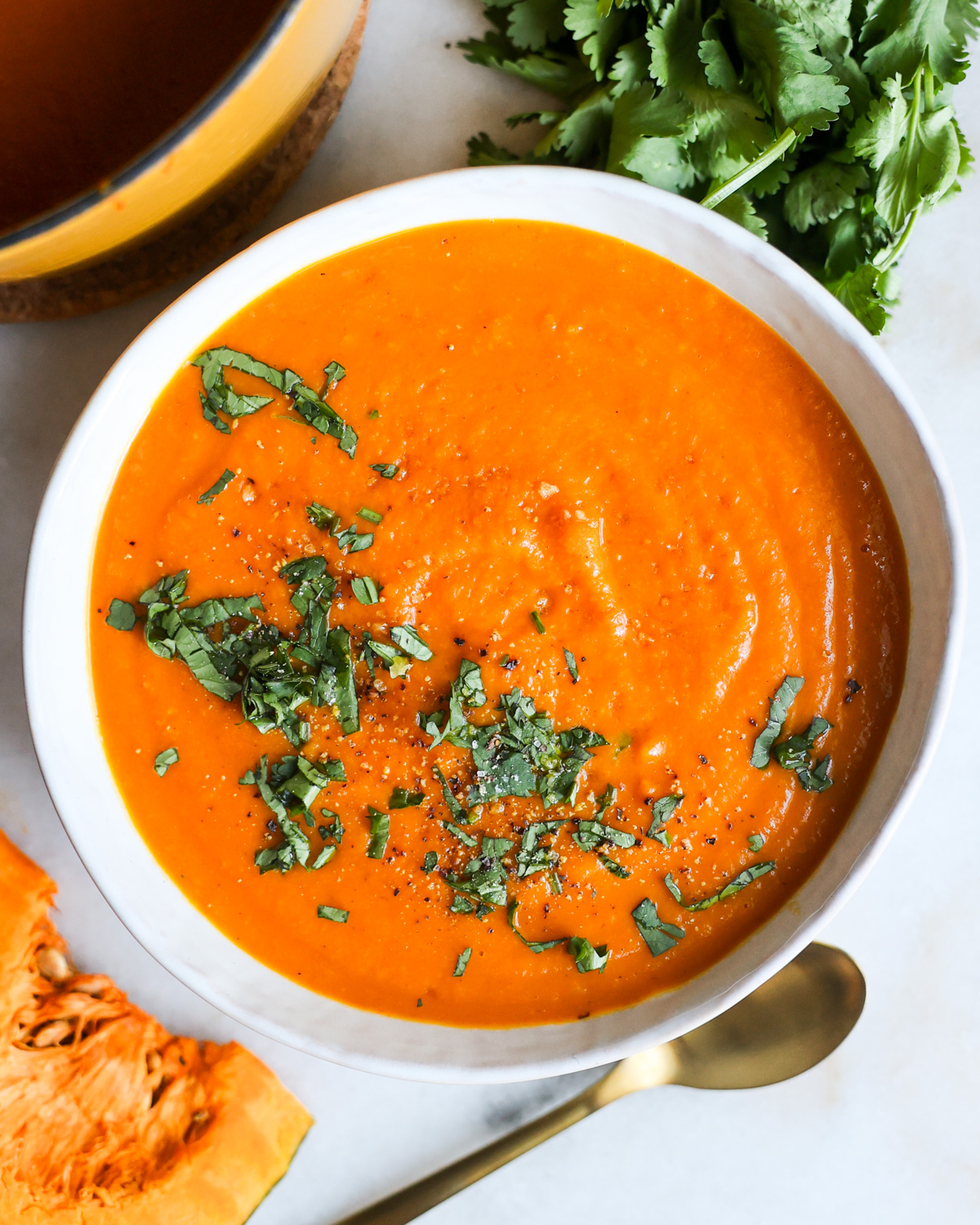
This post was originally written on February 13, 2013. It was updated with new recipe information and photos on November 22, 2024.
This roasted kabocha squash soup is bliss in a bowl. It delivers a cozy, satisfying flavor alongside a powerhouse of plant-based nutrients perfect for winter wellness. Roasting the kabocha squash brings out its natural sweetness and velvety texture, which gives the soup a creamy richness when blended without the need for dairy!
Combined with sautéed carrots, onion, garlic, and ginger, each soothing bite of this vegan squash soup is packed with essential vitamins, minerals, and antioxidants to help support immunity, warmth, and well-being during the colder winter months.
The secret ingredient is a vibrant, aromatic Ethiopian Berbere spice blend. It typically contains up to 12 or more spices such as chili peppers, paprika, ginger, garlic powder, fenugreek, coriander, cumin, cardamom, and cinnamon (to name a few) to create a warm, slightly spicy, and complex flavor profile. The spices, squash, and veggies make each spoonful of this wholesome kabocha soup recipe a nourishing treat for your body and soul.
For more vegan soup recipes, try my Sweet Potato Soup, Curried Parsnip Soup, or Vegan Butternut Squash Soup.
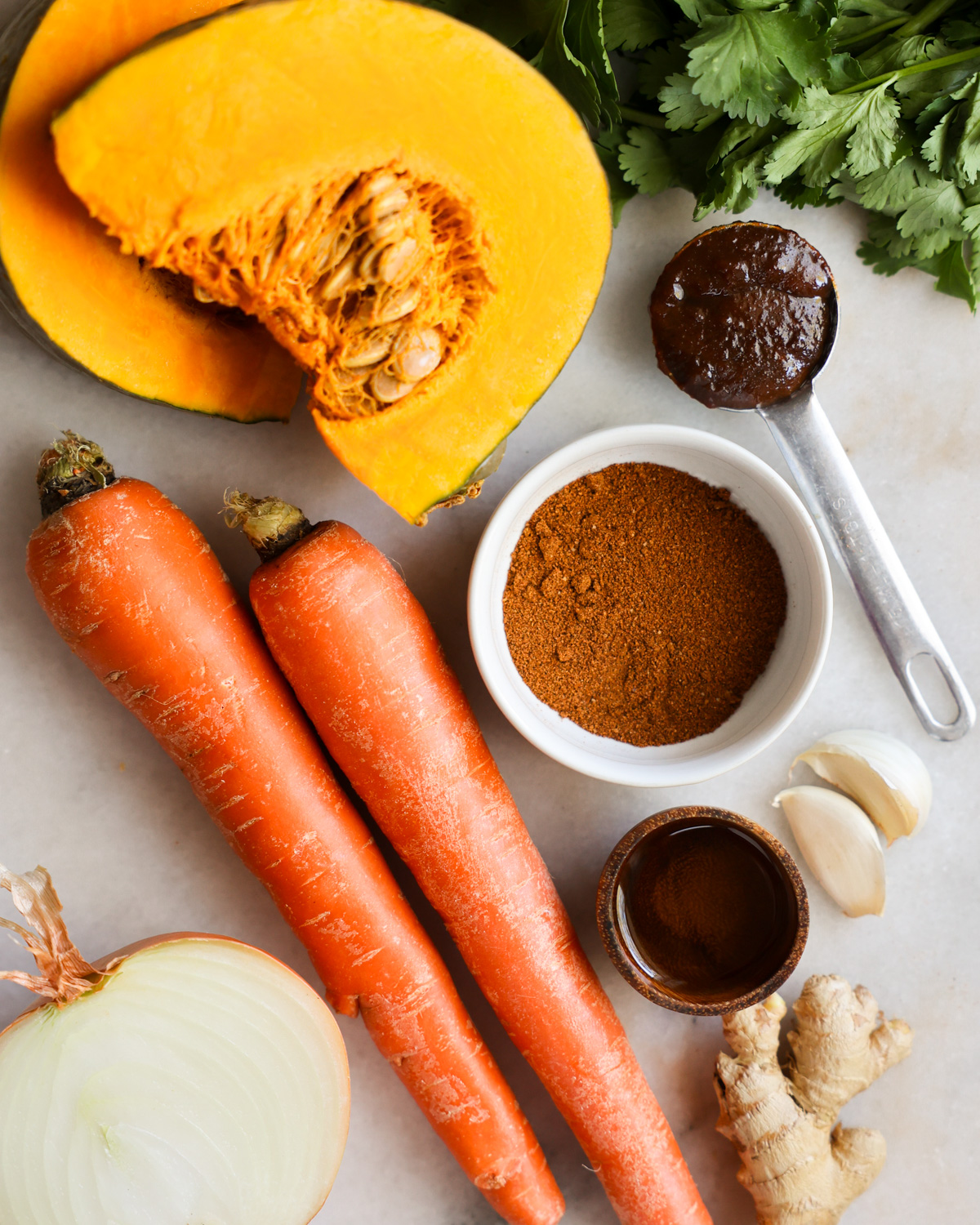
Ingredients
Kabocha Squash: This Japanese winter squash (also referred to as Japanese pumpkin) is known for its sweet, nutty flavor and smooth, creamy texture when roasted. Choose a squash that feels heavy for its size and has a firm, unblemished rind. If you cannot find kabocha squash, substitute with butternut squash for a similar flavor and texture. I don’t love less sweet winter squashes like acorn in this recipe. You could even replace the kabocha with sweet potatoes.
Coconut Oil: Adds a hint of richness with a subtle sweetness and helps enhance the creamy texture of the Japanese squash soup. Swap with extra virgin olive oil for a more neutral, slightly fruity flavor.
Berbere Spice Blend: This traditional Ethiopian spice blend adds a warming, aromatic, slightly spicy depth of flavor, which typically includes 12 or more spices. Find a pre-made spice blend at a spice shop, specialty grocery store, or online. I suggest brands like Frontier Co-op or Eleni’s Kitchen or make your own blend.
Carrots: Bring a natural, earthy sweetness that complements the squash. For the best flavor, choose firm, brightly colored regular table carrots instead of baby carrots.
Onion: Diced yellow onion provides a savory base that enhances the kabocha squash soup vegan flavors. Or use white or sweet onion for a slightly sweeter taste.
Garlic: Adds a savory, aromatic quality that elevates kombucha soup recipes. Mince whole garlic cloves for the most robust taste, or use pre-minced store-bought garlic for convenience.
Ginger: Fresh minced ginger adds a zesty, warming kick that contributes to the soup’s depth and offers anti-inflammatory benefits.
Water or Vegetable Broth: These add moisture to the soup. Use low-sodium broth if desired to control the seasoning of the soup.
Vegetable Bouillon Paste: If you choose to use water instead of vegetable broth, add Better Than Bouillon vegetable bouillon paste to enhance the soup’s flavor. This is my preference.
How to Make Kabocha Squash Soup
- Prepare the kabocha squash. Preheat the oven to 425°F. Cut the kabocha squash in half lengthwise and scoop out the seeds with a spoon.
- Roast the squash. Drizzle a bit of olive oil over each squash half, then place them cut-side down on a baking sheet. Roast for about 30 minutes, or until the flesh is fork tender. Remove from the oven and let it cool until you can handle it comfortably.
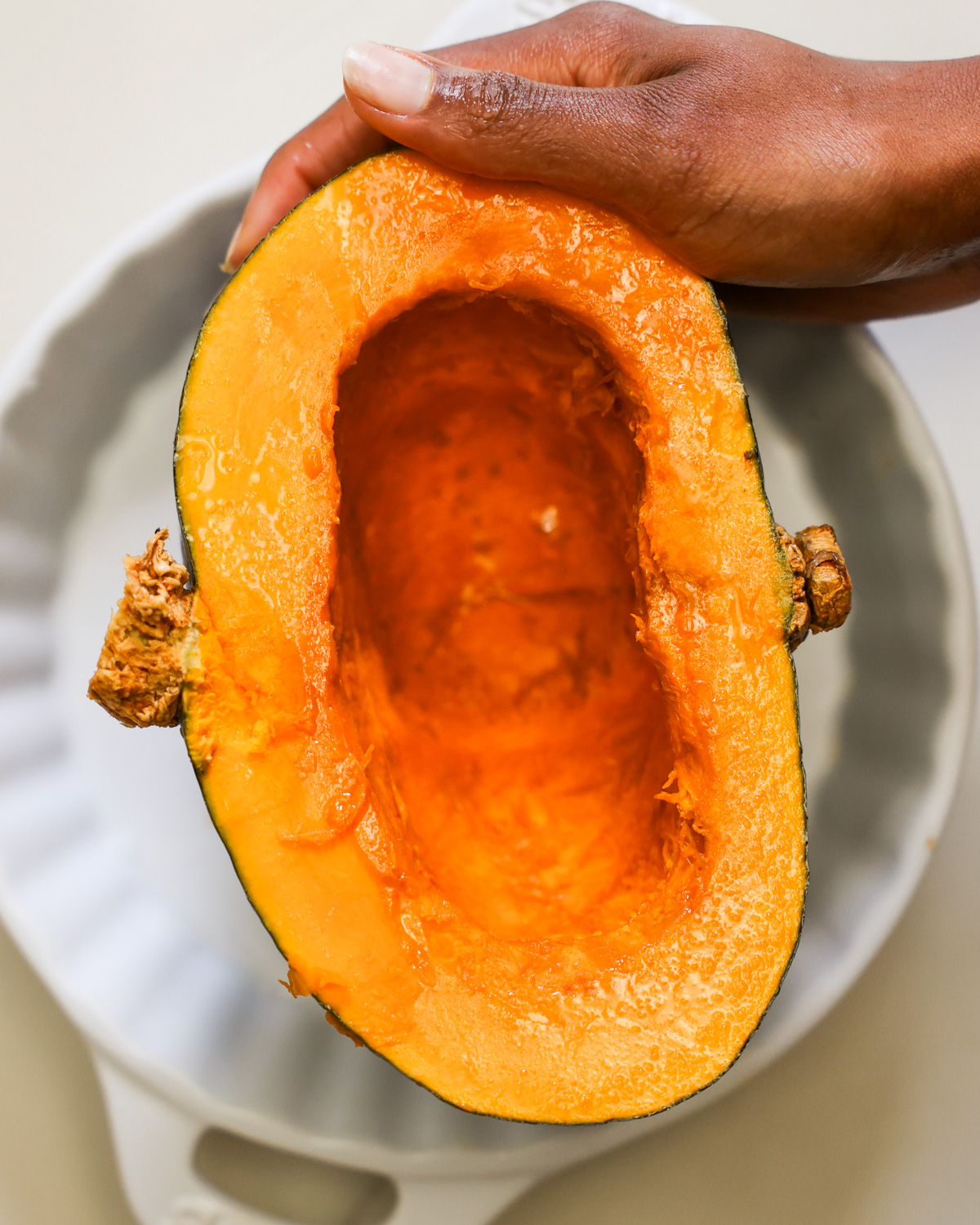
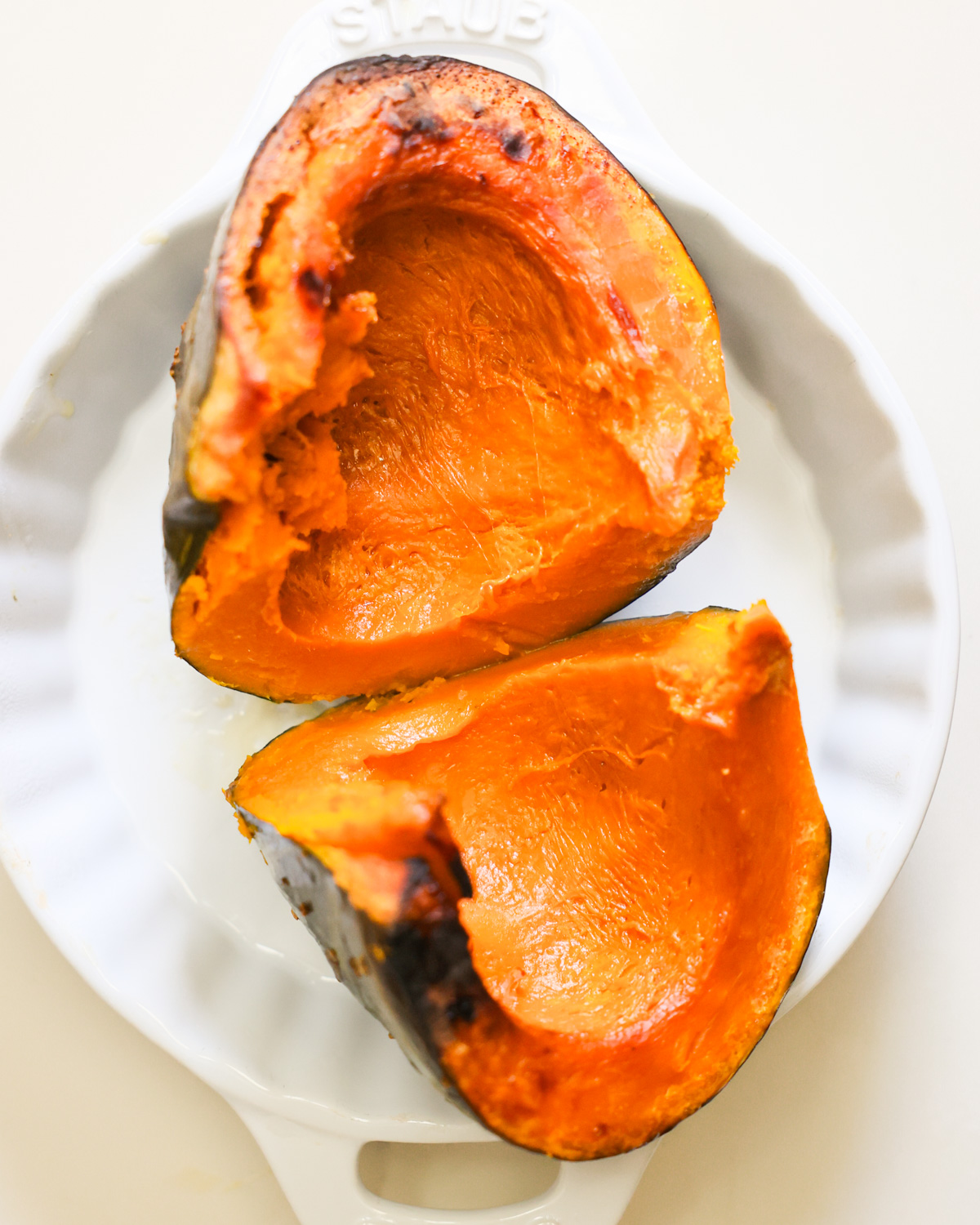
- Sauté the veggies. In a large pot, heat the coconut oil over medium-high heat. Once the oil has melted and is warm, add the onion, minced garlic, and ginger to the pot and stir. Cook until the onions are translucent.
- Add the spice. Then add the Berbere spice blend. Toast the spices with the onions for about 20 seconds, stirring occasionally, to release and intensify their flavors.
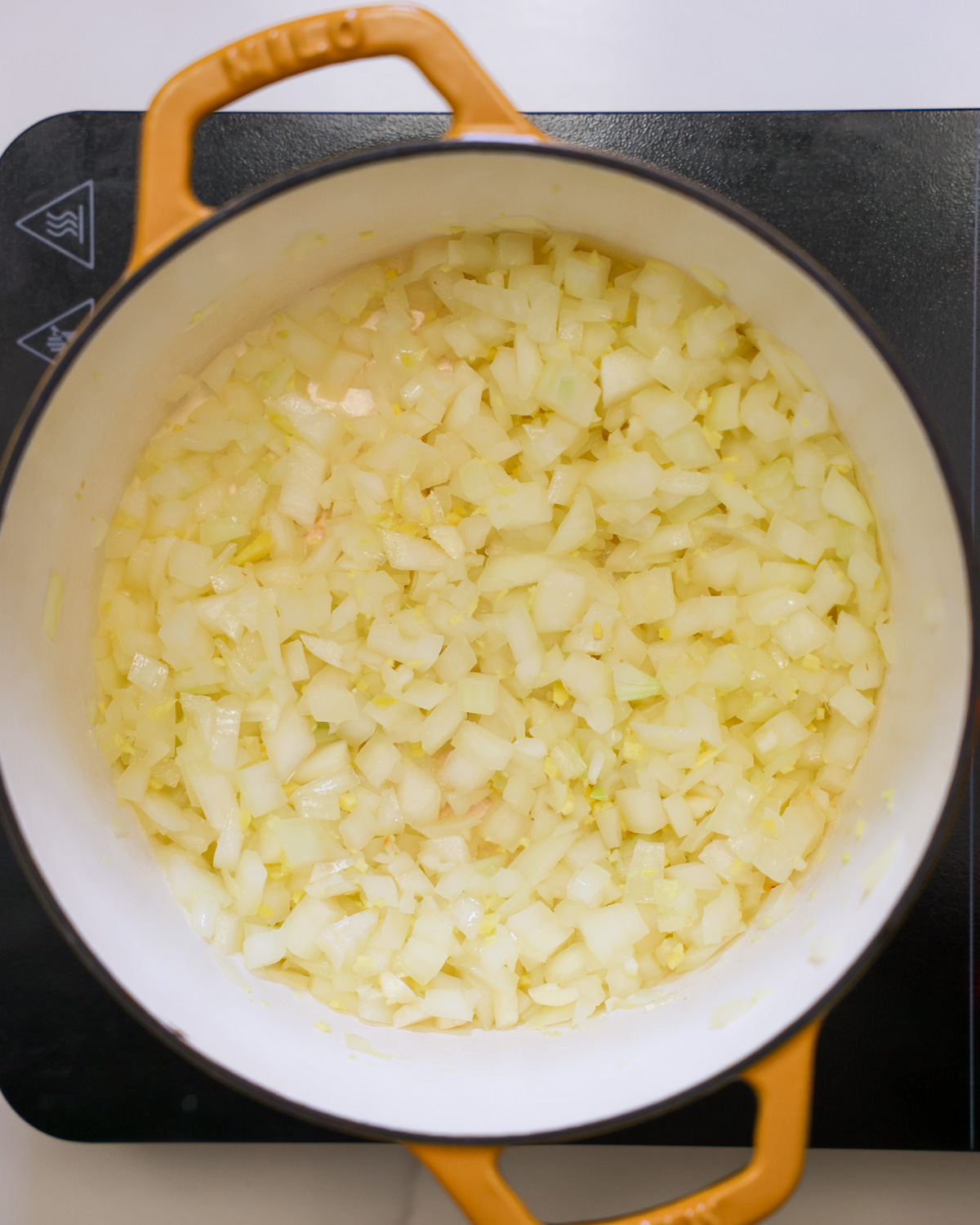
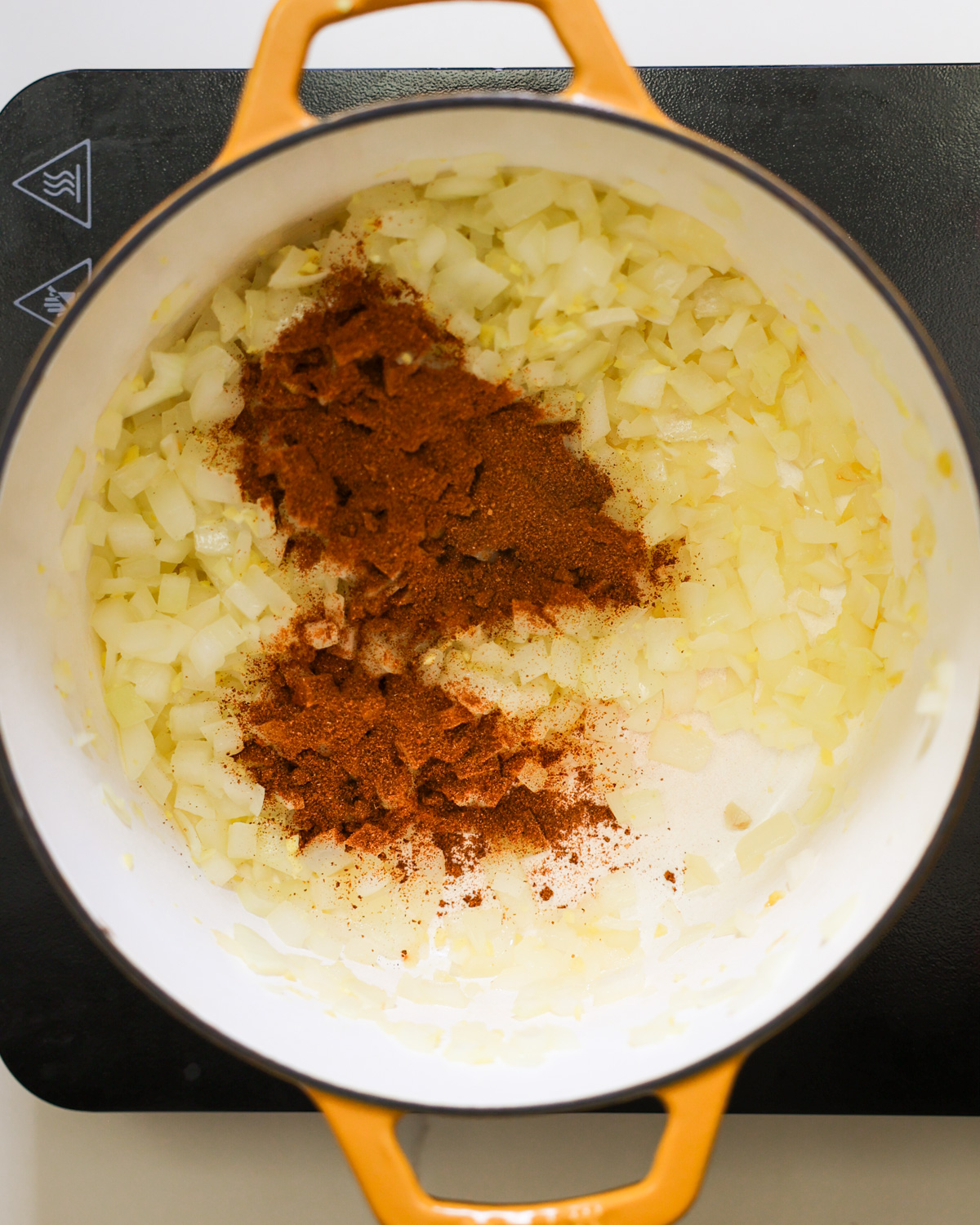
- Add the carrots and liquid. Add the carrots and the water or vegetable broth to the pot and bring it to a simmer. Once it begins to simmer, add the vegetable bouillon paste (if using). Continue to simmer until the carrots are fork tender, about 20 minutes.
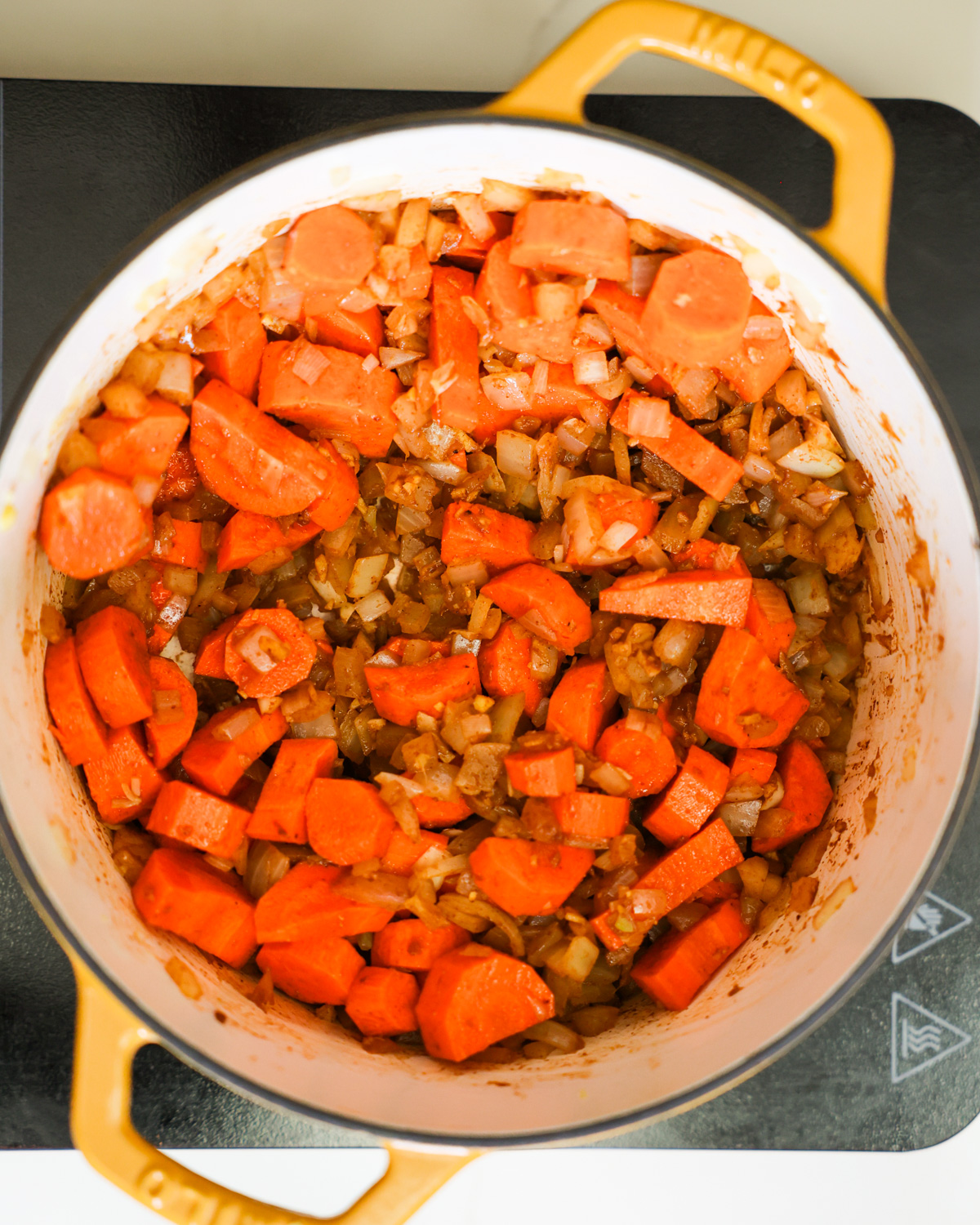
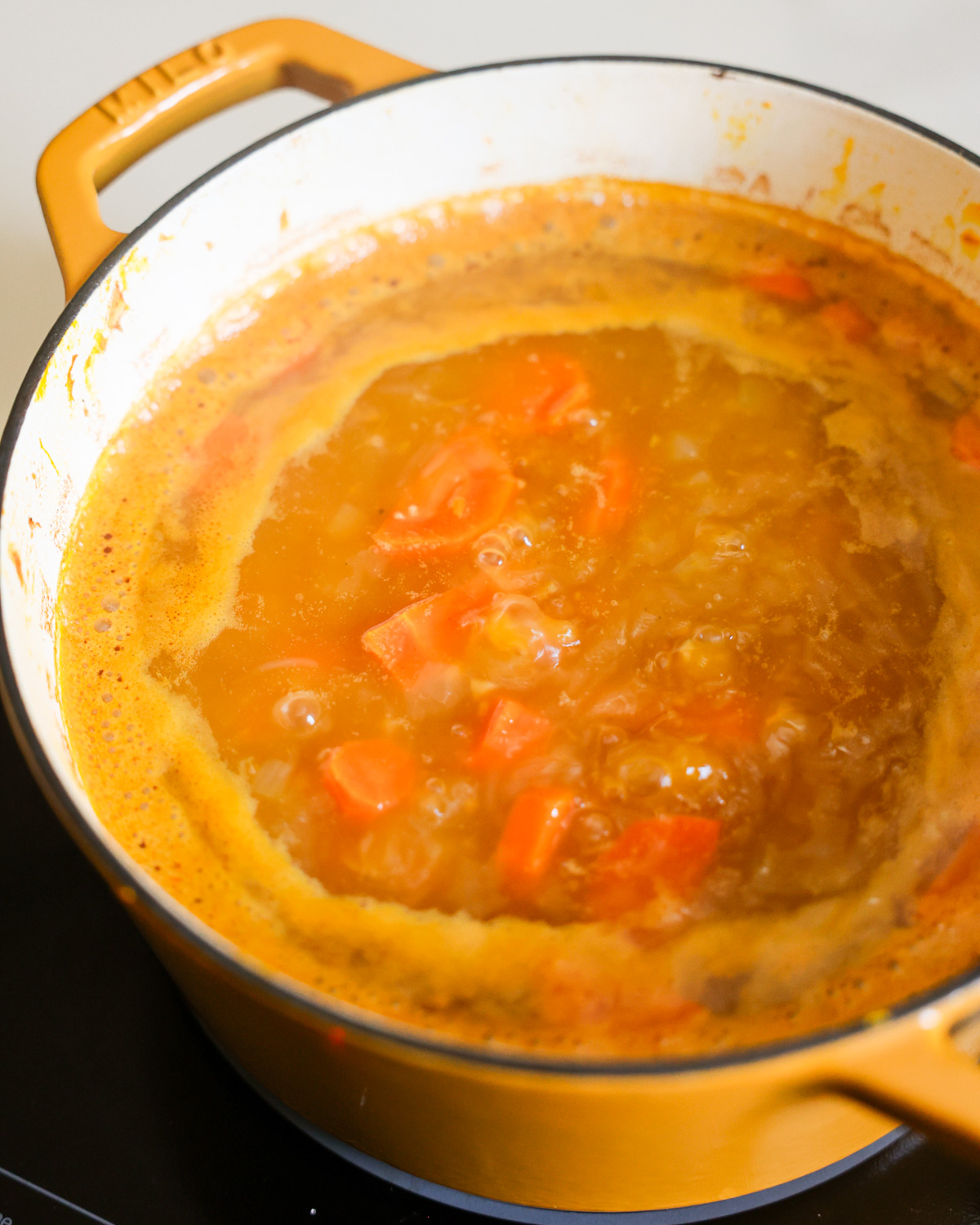
- Add the squash. When the carrots are tender, and the squash is roasted, carefully scoop out the flesh of the kabocha squash and add it to the pot. Stir it well, then remove from the heat.
- Blend. Insert an immersion blender into the pot and puree the soup. If you don’t have an immersion blender, let the soup cool for 5-10 minutes or until cool enough to carefully transfer it to a blender. Remove the lid vent, drape it with a clean dish towel, and blend on medium speed until smooth.
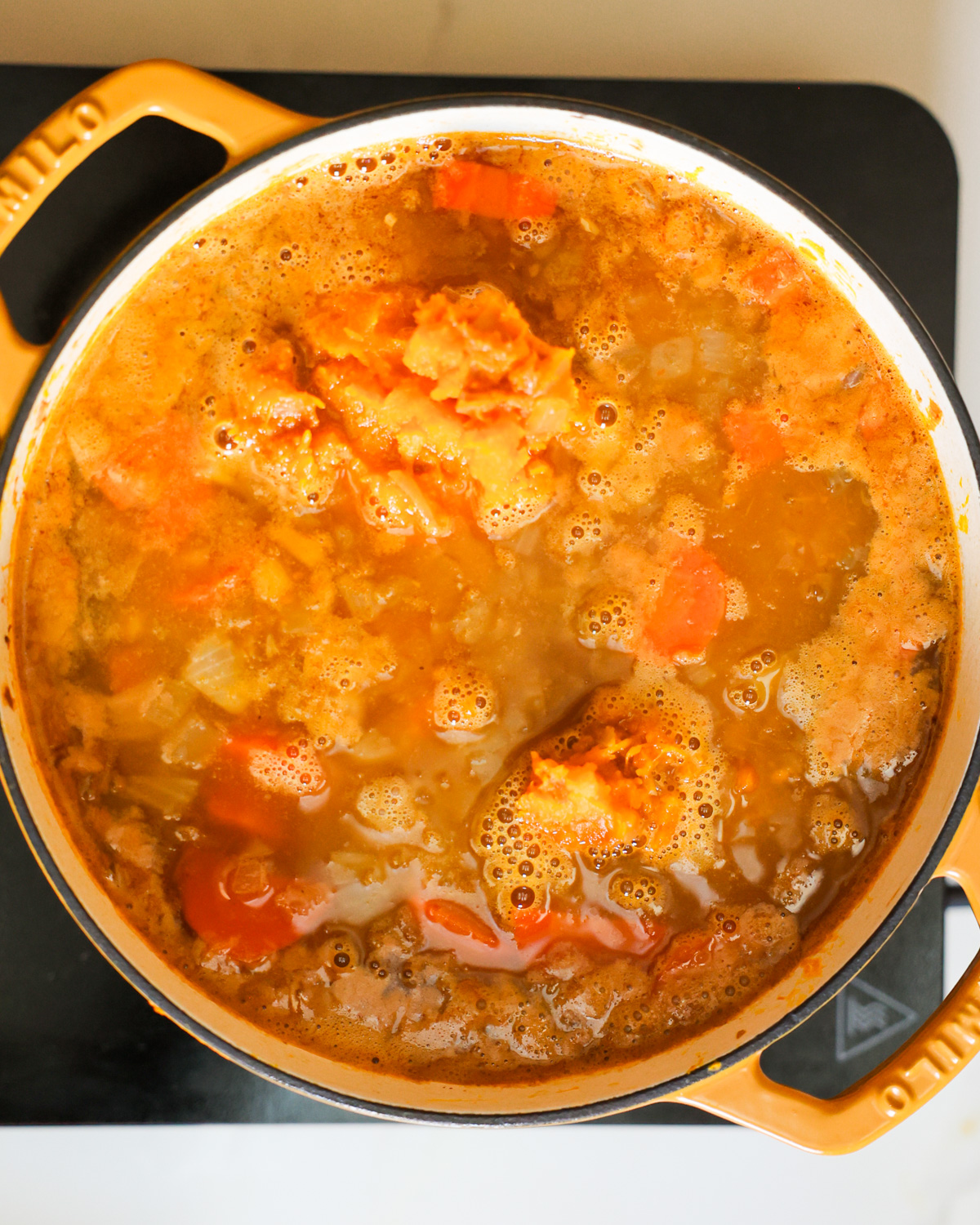
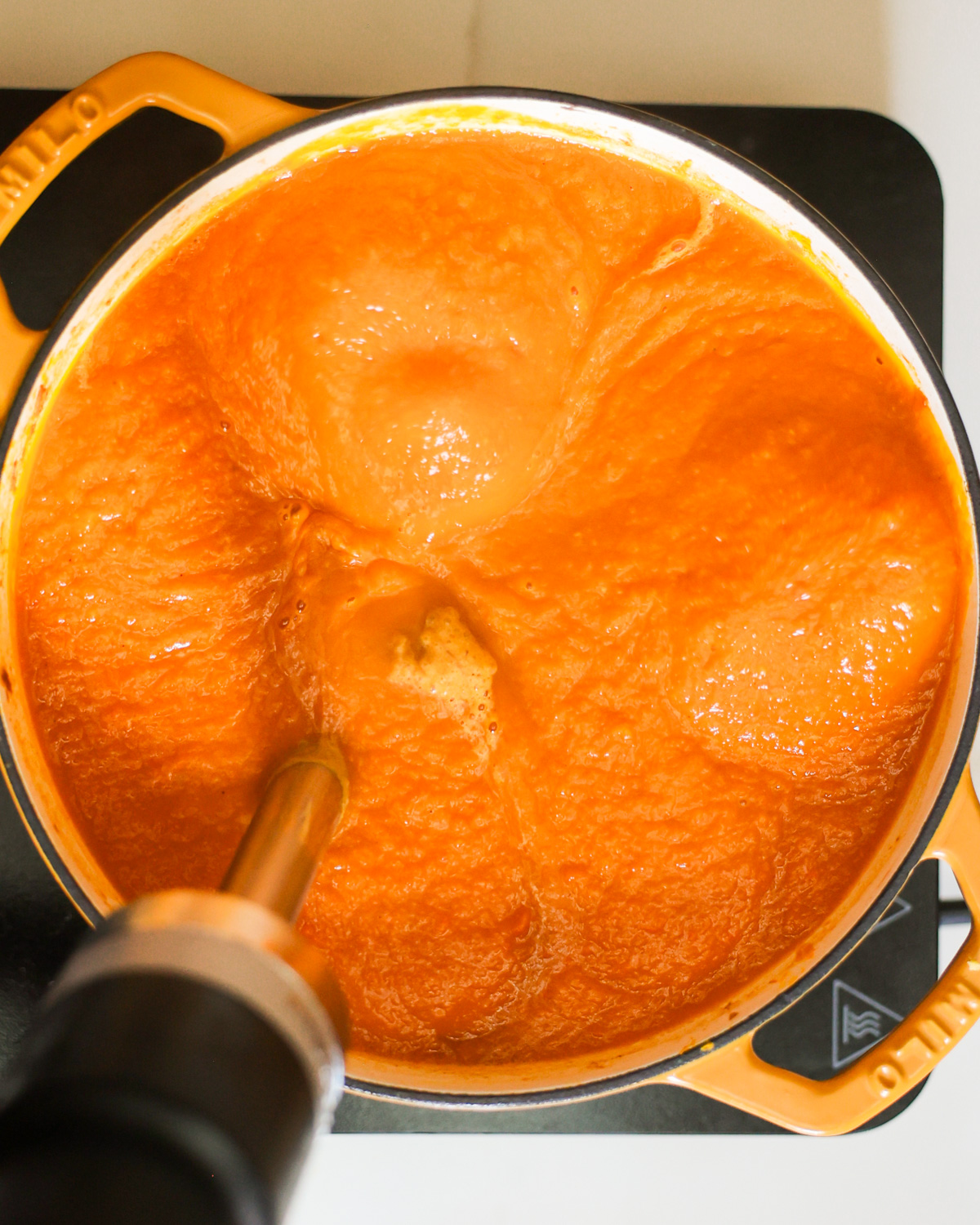
- Serve. Season the pureed Japanese pumpkin soup to taste with more Berbere, salt, and pepper. Garnish with fresh cilantro and serve!
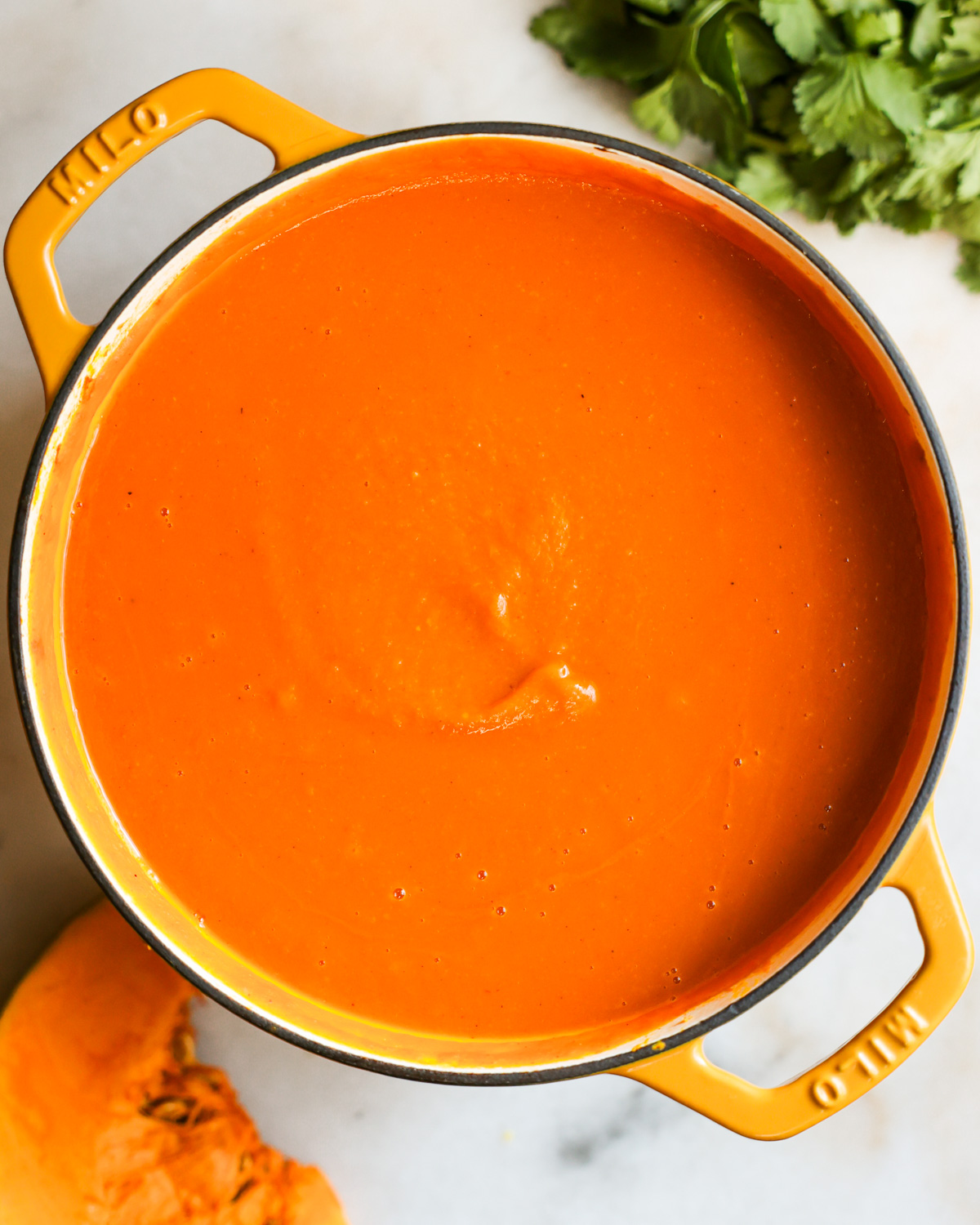
Jenné’s Recipe Pro-Tips
- Season the squash before roasting. For an even richer squash flavor, sprinkle a pinch of salt and cinnamon on the squash halves after drizzling them with olive oil before roasting.
- Handle the squash with care. Wait to handle the roasted squash until it is a safe temperature to prevent burning yourself. Once it’s cooled down, you can remove the inner flesh.
- Adjust the spice to taste. Berbere can be a bit spicy, so start with the recommended amount and adjust as needed. If you prefer a milder kabocha squash soup, start with less Berbere and add it gradually, tasting as you go.
- Blend. Once the soup has finished cooking and the vegetables are tender, blend the soup until smooth and creamy. Use an immersion blender directly in the pot for ease, though a high-speed blender can make the soup more silky and evenly blended. If using the blender, leave the lid slightly vented to release steam and prevent hot splatters.
- Garnish. Top each bowl with freshly chopped cilantro or your garnish of choice to add a pop of color and added texture.
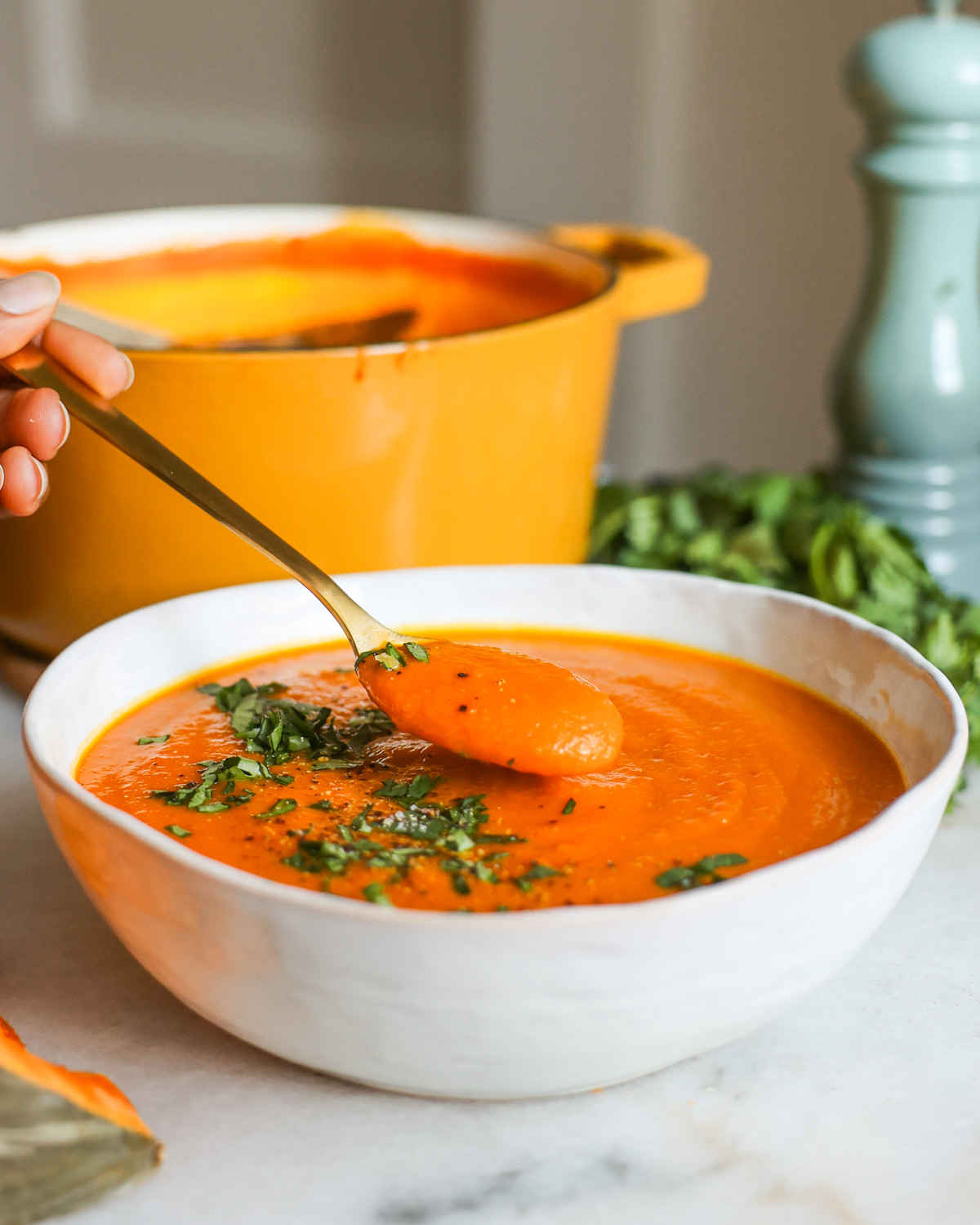
Kabocha Squash Soup Recipe Variations
Customize your soup with the following optional variations:
- Extra Creamy: Stir in ¼ cup of full-fat coconut cream or cashew milk just before serving for an even richer, creamier soup. This enhances the soup’s natural sweetness and adds a velvety finish.
- Spice Blend: If you don’t have Berbere, you can achieve a similar warmth and depth of flavor by using one of the following:
- 1 teaspoon of curry powder with ½ teaspoon of smoked paprika
- 1 teaspoon of Garam Masala with a pinch of cayenne pepper to taste
- 1 teaspoon of chili powder, ½ teaspoon of cumin, and a small pinch of cinnamon to taste.
- Veggie Boost: Add 1 medium diced and peeled sweet potato or 2 medium diced and peeled parsnips when you sauté the carrots. Adjust the cooking time until all the vegetables are tender.
- Herbs: Mix in ½ cup of fresh, roughly chopped parsley or basil leaves just before serving. This adds a burst of freshness that complements the earthly flavors.
- Citrus: Add the juice of ½ lemon or 1 lime just before serving for a refreshing balance to the rich soup.
- Protein: Stir in 1 15-ounce can of rinsed and drained chickpeas about 10 minutes before the soup finishes cooking for added protein or texture. Alternatively, top each bowl with ¼ cup of roasted chickpeas for extra crunch.
- Nutty Garnish: Top the soup with ¼ cup of toasted pumpkin seeds, sunflower seeds, or 2 tablespoons of chopped roasted tamari almonds for a crunchy, nutritious garnish.
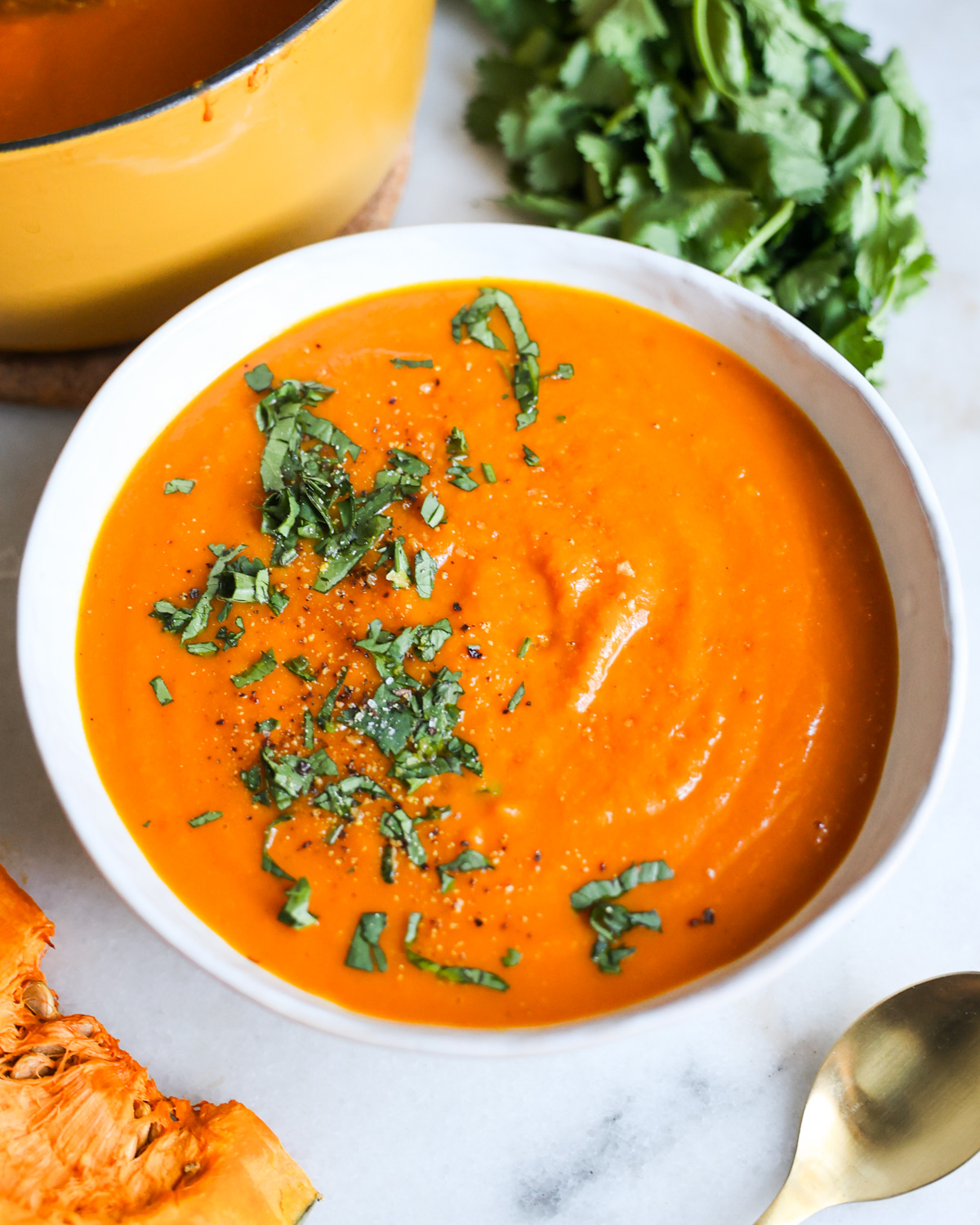
Serving Suggestions
Serve this hearty kabocha squash recipe soup for any occasion, whether it’s a cozy dinner or a festive gathering. Pair with a side of crusty bread for a simple yet delicious meal or some of our favorite recipes below for a full-spread meal:
Storage Directions
- Refrigeration: Allow leftover soup to cool completely before transferring to an airtight container and storing for up to 3-4 days.
- Freezing: Pour cooled soup into single serving containers or one large airtight container for up to 3 months. Leave a little space at the top of the container to allow the soup to expand as it freezes. Thaw in the refrigerator overnight before reheating.
- Reheating: Reheat the soup on the stovetop over medium heat, stirring occasionally until it reaches your desired temperature.
More Vegan Soup & Stew Recipes
- Chickpea & Butternut Squash Tagine
- Instant Pot Black Bean Soup
- Nut-Free West African Peanut Stew
- Collard Miso Soup
- Sweet Potato Tortilla Soup
Save now, cook later.

Ethiopian-Spiced Kabocha Squash Soup
Equipment
- immersion blender I have this one
Ingredients
- 1 3 lb Kabocha squash, aka Japanese Pumpkin, halved and seeds removed
- 2 tbsp coconut oil, or olive oil
- 1 tbsp Berbere spice blend, plus more to taste
- 1 lb carrots, scrubbed well, trimmed, and sliced
- 1 onion, diced
- 2 cloves garlic, minced
- 2 tbsp minced ginger, or more to taste
- 6 cups water , OR one quart vegetable broth, plus more water to thin if necessary
- 1 cube Better Than Bouillon vegetable bouillon paste, if not using the vegetable broth
- 1 cup cilantro, minced (optional)
- salt and pepper, to taste
Instructions
- Preheat oven to 425°. Drizzle a little oil onto each half of the kabocha squash, then place face up on a baking sheet and roast for 30 minutes. Remove from oven, and allow to cool enough to handle.
- In a large pot, warm coconut oil on medium-high heat. Add the onions, garlic, and ginger. Cook until onions are translucent, about 3 minutes. Stir in the Berbere and toast with the onions for about 20 seconds to ignite the flavors.
- Add the carrots, followed by the 6 cups of water (or veggie broth, if using). Bring it to a simmer, and add the vegetable bouillon paste. Simmer and cook for 20 minutes, or until the carrots are tender.
- Scoop out the flesh of the kabocha squash and add it to the pot. Remove the soup from the heat. Using an immersion blender, puree the soup. If you don't have an immersion blender, let the soup cool for 5-10 minutes or until cool enough to carefully transfer it to a blender. Remove the lid vent, drape it with a clean dish towel, and blend on medium speed until smooth and creamy.
- Season the pureed soup to taste with more Berbere, salt, and pepper. Garnish with fresh cilantro and serve!
Notes
- Refrigeration: Allow leftover soup to cool completely before transferring to an airtight container and storing for up to 3-4 days.
- Freezing: Pour cooled soup into single serving containers or one large airtight container for up to 3 months. Leave a little space at the top of the container to allow the soup to expand as it freezes. Thaw in the refrigerator overnight before reheating.
- Reheating: Reheat the soup on the stovetop over medium heat, stirring occasionally until it reaches your desired temperature.
- Season the squash before roasting. For an even richer squash flavor, sprinkle a pinch of salt and cinnamon on the squash halves after drizzling them with olive oil before roasting.
- Handle the squash with care. Wait to handle the roasted squash until it is a safe temperature to prevent burning yourself. Once it’s cooled down, you can remove the inner flesh.
- Adjust the spice to taste. Berbere can be a bit spicy, so start with the recommended amount and adjust as needed. If you prefer a milder soup, start with less Berbere and add it gradually, tasting as you go.
- Blend. Once the soup has finished cooking and the vegetables are tender, blend the soup until smooth and creamy. Use an immersion blender directly in the pot for ease, though a high-speed blender can make the soup more silky and evenly blended. If using the blender, leave the lid slightly vented to release steam and prevent hot splatters.
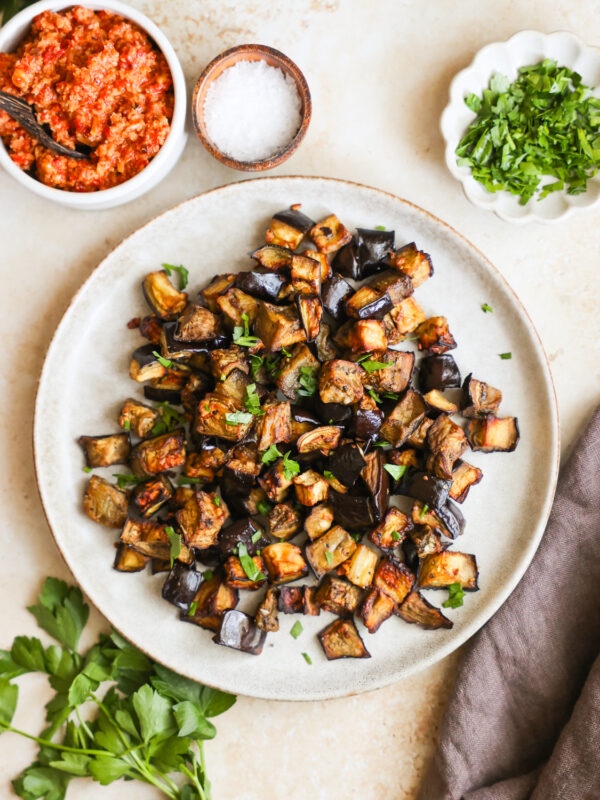









Really nice soup! I topped with pepita seeds for some extra crunch 😉
Yummy addition! I love that pepitas are so nutritious too 🙂
Thanks for commenting and rating.
delicious! thank you. I baked my kabocha squash whole, then cut in half and scooped out the guts. I threw the rest of the squash into the soup including the skin, which was thin and made for a nice colorful soup with flecks of dark green. it was amazing!
Yummy! And by doing that you increased the nutrients. Fantastic! Thanks for sharing 🙂
Absolutely delicious! Thank you.
Tremendous! Love the extra tips at the end, thanks so much!
Glad you enjoyed, Jan!! Happy New Year!